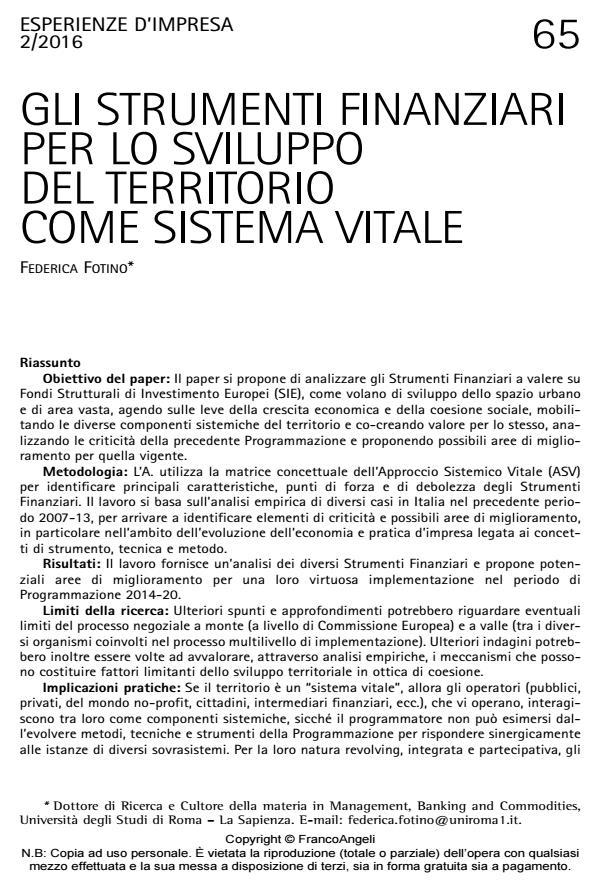Gli strumenti finanziari per lo sviluppo del territorio come sistema vitale
Journal title ESPERIENZE D'IMPRESA
Author/s Federica Fotino
Publishing Year 2018 Issue 2016/2
Language Italian Pages 33 P. 65-97 File size 393 KB
DOI 10.3280/EI2016-002004
DOI is like a bar code for intellectual property: to have more infomation
click here
Below, you can see the article first page
If you want to buy this article in PDF format, you can do it, following the instructions to buy download credits

FrancoAngeli is member of Publishers International Linking Association, Inc (PILA), a not-for-profit association which run the CrossRef service enabling links to and from online scholarly content.
Purpose of the paper: The paper aims to analyse the Financial Instruments, under the Cohesion Policy framework, acting as a key driver for the urban and territorial development, underpinning economic growth and social cohesion, and facilitating the mobilization of the systemic components operating in the region and the value co-creation process for the territory. It identifies critical elements during the previous programming period and potential areas of improvement for the current period 2014-20. Methodology: The A. adopts the Viable Systems Approach (VSA) to identify the main characteristics, strengths and weaknesses of the Financial Instruments. The work is based on an empirical analysis of a number of cases in Italy, during the period 2007-13, with the aim of detecting critical elements and potential areas of improvement, particularly in the context of the management theory and practice related to the concepts of instrument, technique and method. Findings: Leveraging on the analysis of the Italian case in 2007-13, the A. identifies common features and critical factors and finally proposes potential areas for improvement in the design and implementation of Financial Instruments during the current programming period 2014-20. Research limits: Further insights could address any limitations of the upstream (at European Commission level) and downstream (between the various bodies involved in the multi-level implementation process) negotiation process and empirically investigate possible limiting factors for the territorial development in a Cohesion perspective. Practical implications: If the territory is a "viable system", then the social and economic operators (public, private, non-profit, citizens, financial intermediaries, etc.) will interact with each other as systemic components. Consequently, the policy maker needs methods, technics and tools able to synergically respond to a multitude of suprasystems’ needs. For their revolving, integrated and participative nature, Financial Instruments result to be particularly suited to be analysed through the conceptual and interpretive methodology of the VSA, which may contribute at creating innovative models to optimize the use of European Structural Investment (ESI) funds and maximize positive impacts on the territory. Originality of the paper: In the opinion of the A., the consolidation of the Financial Instruments represent a new modus pensandi concerning the spatial planning, which goes beyond structure-centric approaches (focusing on public grants and single initiatives), to adopt vital-systemic approaches (which provide for development strategies based on relationships and interrelationships between the systemic components and supra-systems, through integrated programmes and value co-creation models). According to such interpretative scheme, the various territorial players shall work in partnership, aligning their evolutionary paths, towards a "context consonance", with the final aim to ensure the sustainability - and therefore the long-term survival capacity - of the whole system: not only the enterprise, financial or political systems, but also the neighborhood, the city, in other words, the whole "territorial system". To this aim, the A. argues that a critical reflection is needed, together with the refinement of the practical approach, to territorial issues in the context of Cohesion Policy.
Keywords: Viable Systems Approach, European Structural and Investment Fund, Financial Instrument, Government of territory, Cohesion Policy, Urban Development
Federica Fotino, Gli strumenti finanziari per lo sviluppo del territorio come sistema vitale in "ESPERIENZE D'IMPRESA" 2/2016, pp 65-97, DOI: 10.3280/EI2016-002004